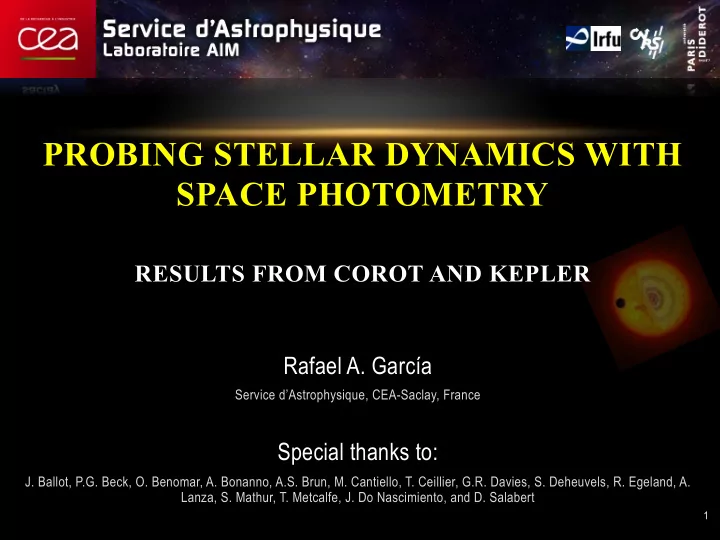

PROBING STELLAR DYNAMICS WITH SPACE PHOTOMETRY RESULTS FROM COROT AND KEPLER Rafael A. García Service d’Astrophysique, CEA-Saclay, France Special thanks to: J. Ballot, P.G. Beck, O. Benomar, A. Bonanno, A.S. Brun, M. Cantiello, T. Ceillier, G.R. Davies, S. Deheuvels, R. Egeland, A. Lanza, S. Mathur, T. Metcalfe, J. Do Nascimiento, and D. Salabert 1
I-INTRODUCTION Ø What can offer high-precision photometry (HPP) to better understand stellar dynamics, magnetism & dynamos ? § HPP observations can potentially give access to: • Surface (differential?) rotation of hundred to thousand stars [e.g. McQuillan et al. 2013, 2014; Nielsen et al. 2013; Reinhold & Reiners 2013, 2015; García et al. 2014] • Internal (differential?) rotation through seismology [e.g. Beck et al. 2012; Deheuvels et al. 2012,2014,2015; Mosser et al. 2012, § Convection properties Nielsen et al. 2014, Benomar et al. 2016, Pia di Mauro et al. 2016, • Characteristic time scale of convection (granulation) [e.g. Mathur et al. 2011; Kallinger et al. 2014, 2016] § other scales: • e.g. Faculae in active stars [e.g. Karoff et al. 2013] § Internal structure (through seismology) [e.g. Mathur et al. 2012; Mazumdar et al. 2014; • Size of the convective envelope (through seismology (+ modelling)) Metcalfe et al. 2014,…] • Constraining deep internal magnetic fields & convective core dynamos [Fuller et al. 2015.; Stello et al. 2016a,b] § Activity cycles & surface magnetism • Through the analysis of long time series (activity proxies) [e.g. García et al. 2010; Mathur et al. 2013, 2014, Salabert et al. 2016] § Or asteroseismology [e.g. García et al. 2010; Régulo et al. submitted] 2
IIa-Stellar Dynamics: Surface Rotation 3
II-SURFACE ROTATION [McQuillan et al. 2014] 4
II-SURFACE ROTATION (M-S & SUB-RG) Ø ~540 solar-like stars showing p-mode oscillations have been measured (1 month) [Chaplin et al. 2014] § Reliable surface rotation rates and photospheric magnetic index obtained for 310 stars Ø Stars in which pulsations are measured => Low surface activity (biased sample) [Garcia et al. 2010; Chaplin et al. 2011] [García et al 2014] 5
II-SURFACE ROTATION OF (SEISMIC) KOI S Ø Gyrochronology must be calibrated using stars of known age (published relations mostly employ open cluster stars and the Sun). § Until now, gyrochronology has simply extrapolated these trends to stars older than the Sun. § Ø Using also confirmed stars holding planets Small planets in the range 0.7 to 3.94 R � with semi-major axes range from 0.035 to 0.392 AU § Differences are due to a difference mass distribution § [See Van Saders presentation tomorrow] Field stars (García et al. 2014) Stars harbouring planets (Ceillier et al. 2016) 6 [see also Angus et al. 2015, Paz-Chinchón et al. 2015, Van Saders et al. 2016]
II-SURFACE ROTATION (RGB-RC) Average rotation splitting measured for ~300 RG stars Ø Ensemble analysis of 17,000 Kepler pulsating RGs § ~361 shows reliable surface rotation (blue) § 171 that could be due to pollution (grey) Ø As expected § Most are RC stars § Some possible mergers detected 7 [Ceillier, Tayar, et al. to be submitted]
III-Stellar Dynamics: Surface magnetism 8
III-STELLAR VARIABILITY Ø Example of the PSD of a Solar-Like star Granulation Photon noise 9
II-MAGNETIC ACTIVITY & ROTATION VIRGO/SPM [García, Salabert, Mathur et al. 2013]
II-MAGNETIC ACTIVITY & ROTATION [Salabert et al. in preparation]
III-SURFACE MAGNETIC ACTIVITY S-L STARS Ø The photospheric magnetic activity of the pulsating solar-like stars [García et al. 2014] § Compatible with the solar magnetic activity during the solar cycle (61.5%) § But large range of inclination angles and position in an on-going long activity cycle 12
III-SURFACE MAGNETIC ACTIVITY S-L STARS global oscillation & photometry global oscillation & spectroscopy one-month individual frequencies & spectroscopy nine-month individual frequencies & spectroscopy [Salabert et al., accepted, minor revision ] Ø Analysis of 18 seismic solar analogues observed by Kepler § Solar analogs in Teff and Mass [see also Do Nascimento et al. 2014] • Degeneracy because of the unknown inclination axis and period of the cycle. § The surface magnetic activity of the pulsating solar analogues is similar to the Sun [For the variability of KOIs see: McQuillan et al. 2013; Walkowicz & Basri 2013] 13
III-SURFACE MAGNETIC ACTIVITY S-L STARS MWO Solar Analogues Kepler Solar Analogues [Salabert et al., accepted, minor revision ] Ø Analysis of 18 seismic solar analogs observe by Kepler § Solar analogs in Teff and Mass [see also Do Nascimento et al. 2014] • Degeneracy because of the unknown inclination axis and period of the cycle. § The surface magnetic activity of the pulsating solar analogues is similar to the Sun [For the variability of KOIs see: McQuillan et al. 2013; Walkowicz & Basri 2013] 14
HINTS OF A MAGNETIC-ACTIVITY CYCLE Ø KIC 10644253 : a Solar analogue Kepler § Correlation between S ph and p-mode frequency shifts [Bruntt et al. 2012; Metcalfe et al. 2014; García et al. 2014,Salabert et al. 2016] Teff=6030±150 M=1.13±0.05 R=1.108±0.016 Age=1.07±0.25Gy P rot ~ 11 days I ~ 48 o l=0, l=1 [Salabert et al. 2016] 15
HINTS OF A MAGNETIC-ACTIVITY CYCLE Ø KIC 10644253 : a Solar analogue Kepler § Correlation between S ph and p-mode frequency shifts [Bruntt et al. 2012; Metcalfe et al. 2014; García et al. 2014,Salabert et al. 2016] Teff=6030±150 M=1.13±0.05 R=1.108±0.016 Age=1.07±0.25Gy P rot ~ 11 days I ~ 48 o Ca H&K l=0, l=1 [Salabert et al. 2016] 16 [Salabert et al., accepted, minor revision ]
Thanks 17
Recommend
More recommend